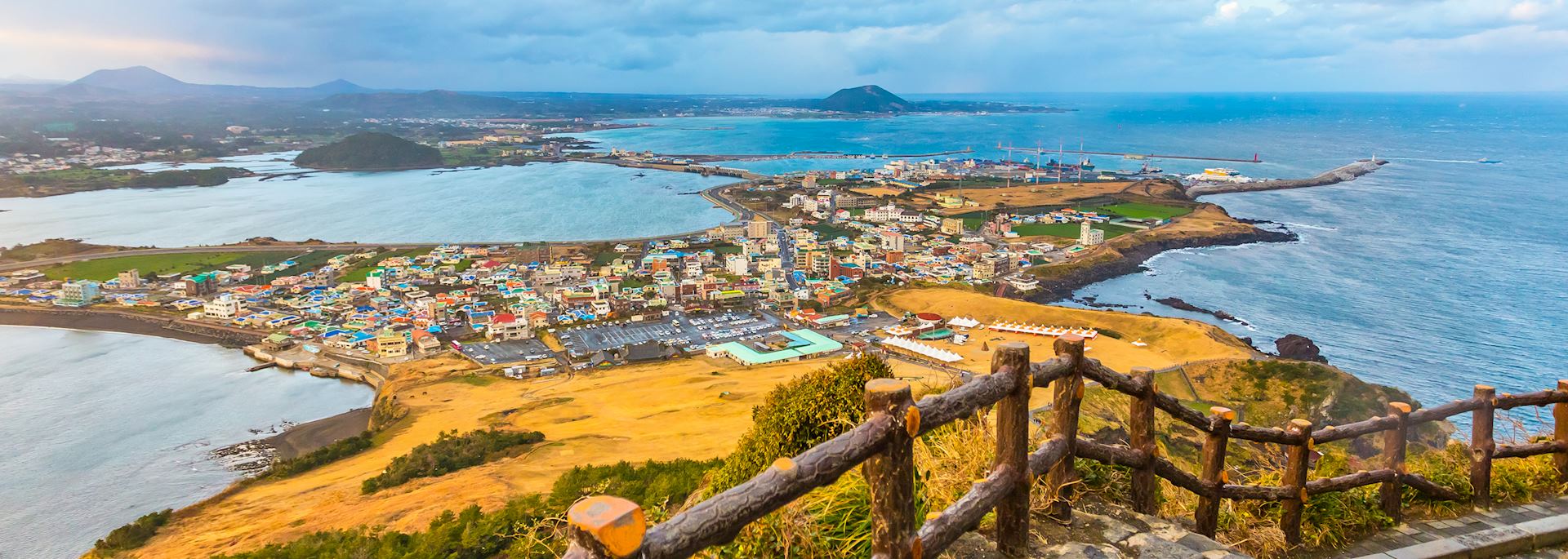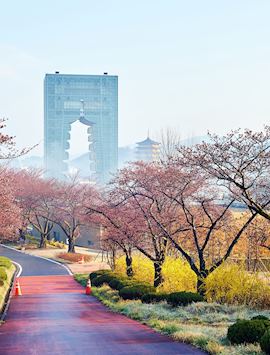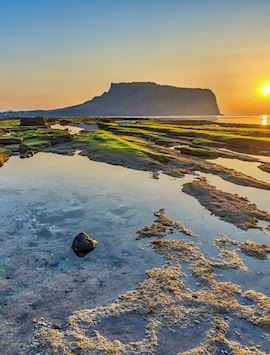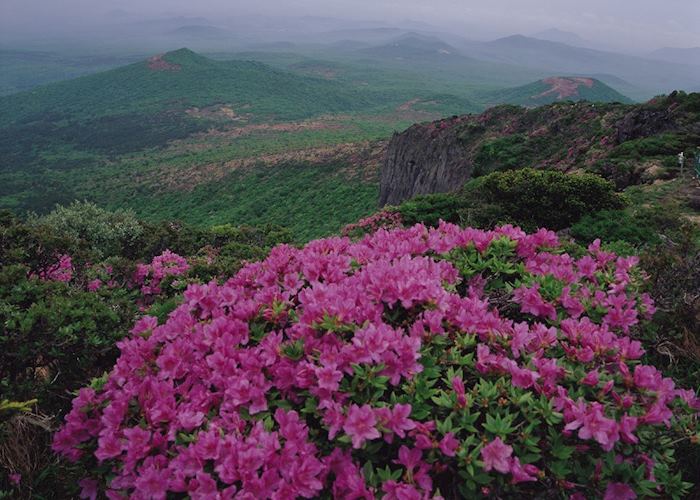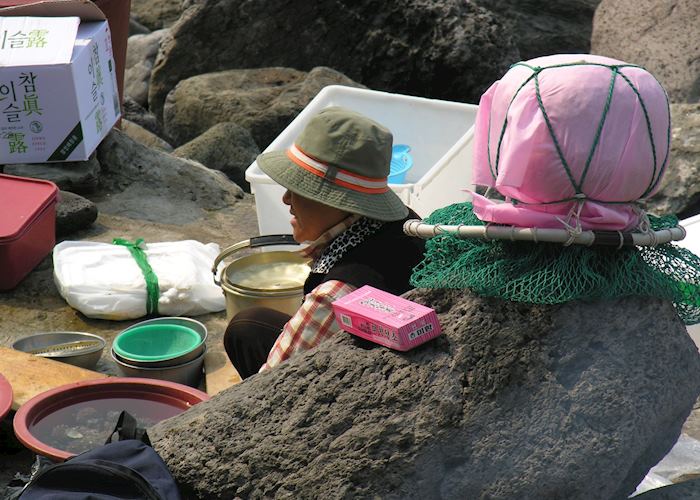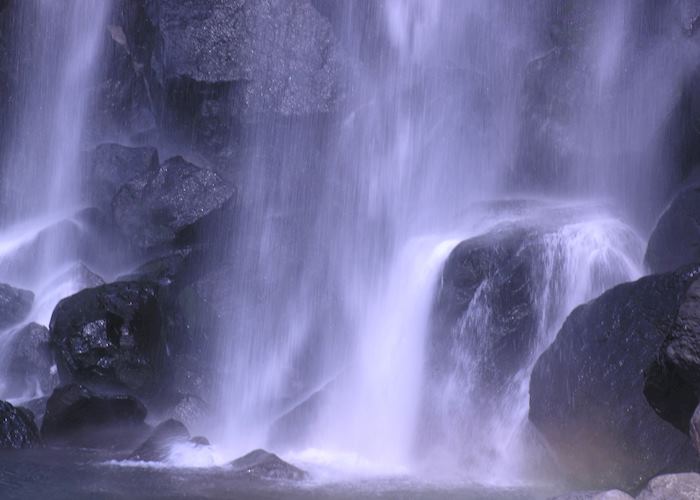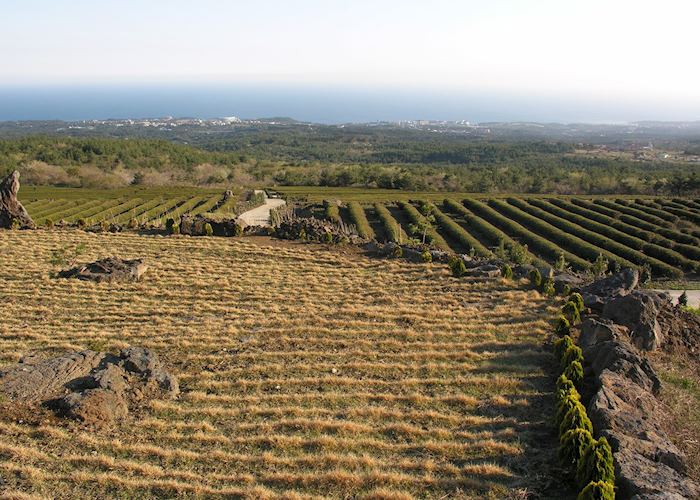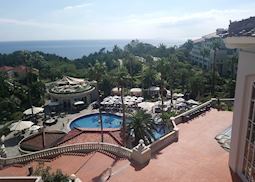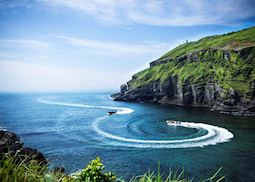Jump to:
Hike up South Korea’s highest peak, watch the sun rise from a volcanic crater, marvel at octogenarian free divers or simply relax on the beach on the subtropical island of Jeju. Sitting off the south coast of the Korean Peninsula, Jeju is littered with volcanic outcrops, lava tubes, waterfalls, citrus orchards, forests and beaches. Its flora and fauna and geological spectacles have led to it being protected as a Biosphere Reserve, UNESCO World Heritage Site and Global Geopark. It’s a great place to relax or hike the network of island trails at the end of your South Korea trip.
 Jeju is dominated by Mount Hallasan, a 1,950 m (6,400 ft) dormant volcano that makes a challenging day hike. A UNESCO Biosphere Reserve, you can spot a variety of alpine plants en route to the summit from where you’ll get panoramic views of the island and the crater lake on a clear day.
Jeju is dominated by Mount Hallasan, a 1,950 m (6,400 ft) dormant volcano that makes a challenging day hike. A UNESCO Biosphere Reserve, you can spot a variety of alpine plants en route to the summit from where you’ll get panoramic views of the island and the crater lake on a clear day.
Another of the island’s most prominent features is Seongsan Ilchulbong, a 182 m (600 ft) volcanic cone that rises abruptly from the sea on the island’s east coast. It only takes about 20 minutes to climb to the forested crater rim and doing so at sunrise is a popular local tradition.
More geological anomalies can be seen at the Manjanggul lava caves where one of the world’s longest lava tubes stretches 8 km (5 miles) below the ground. You can walk along part of its length to see lava stalactites and stalagmites, cave coral and lava bridges.
Udo Island, a popular day trip from Jeju, lies just off the east coast. Its variety of beaches, volcanic landscapes and fields of flowers attract plenty of visitors. You can hike Udobong Peak for panoramic views, see the black-sand beach at Geommeolle or the white-coral beach at Hongjodangoe Haebin, before enjoying some of the fine local seafood.
Much of the region’s seafood is caught by haenyeo, Jeju’s female free divers who harvest oysters, abalone and clams and catch octopus and squid without any equipment other than knives and wetsuits. It’s a dying tradition, but one that has been ongoing for centuries and you may see the divers, many in their 70s and 80s, on the beaches at Jungmun and Seogwipo. To learn more about their lifestyle and traditions, visit the Haenyeo Museum in Gujwa-eup.
If you’d like to get out and explore the island on foot, a network of hiking tracks known as Olle Trails lead along the rugged coastline and through the interior to scenic lookouts. You can hike the entire length of the long-distance trails or just pick short sections to explore. A few to look out for include the ten-minute walk along Olle Trail 6 to Cheonjiyeon Pokpo, a waterfall that drops into an emerald pool surrounded by basalt cliffs and lush forest. Then there’s the Daepo Jusangjeolli coastline, just south of the Jeju International Convention Centre, where columns of basalt rear out of the sea on Olle Trail 8.
To get a sense of local life, it’s worth exploring Jeju city’s Dongmun street food market, a huge place selling everything from fish and seafood to local oranges, household items and souvenirs. It’s a great place to try local dishes, fresh local orange juice or sweet treats such as peanut ice cream or hotteok (cinnamon rice pastries). Nearby is Black Pork Street, a road lined with restaurants serving the island’s most renowned foodstuff, Jeju black pig. Follow the crowds to the most popular spots.
Jeju has long been a popular destination for domestic visitors, and in recent years, ease of access and liberal visa rules have attracted large numbers of Chinese tourists. Even though you can’t expect to have the most renowned views to yourself, it’s well worth a trip and not too difficult to leave the package tours behind and discover a more secluded side of the island.
The island’s hotels are clustered in three areas: Jeju city, its biggest urban hub which is on the north coast; Seogwipo city, a more secluded spot on the south coast; and the Jungmun resort area which has large, family-friendly hotels and access to some of the best beaches on the island with good snorkeling and swimming.
Best time to visit Jeju Island
Mid-March to early April is one of the best times to visit Jeju with cherry blossom, azaleas and magnolias in bloom. May and June offer pleasant weather but July and August are hot, humid and wet. Temperatures drop by September and November sees added interest with the autumnal foliage. Although cold, November to February is dry and hiking Mount Hallasan in the snow is particularly atmospheric.
who's been there

Start planning your tailor-made trip to Jeju island by contacting one of our South Korea specialists
-
617-223-4521617-223-4901
- Make an inquiry
Suggested itineraries featuring Jeju island
Our itineraries will give you suggestions for what is possible when you travel in Jeju island, and they showcase routes we know work particularly well. Treat them as inspiration, because your trip will be created uniquely by one of our specialists.
Photos of Jeju island
Accommodation choices for Jeju island
We've selected a range of accommodation options for when you visit Jeju island. Our choices usually come recommended for their character, facilities and service or location. Our specialists always aim to suggest properties that match your preferences.
-
![Exterior]()
The Shilla Jeju
Jeju island
Ideas for experiencing Jeju island
Our specialists seek out authentic ways to get to know the places that could feature in your trip. These activities reflect some of the experiences they've most enjoyed while visiting Jeju island, and which use the best local guides.
-
Tour of Eastern Jeju Island ![Udo island cliffs]()
Tour of Eastern Jeju Island
Tour of Eastern Jeju Island
Explore the volcanic cones, crater rims and lava tubes of east Jeju on a private guided tour to learn about the region’s geological history. See languid Udo Island and take in some of Jeju Island’s best views.
View details
